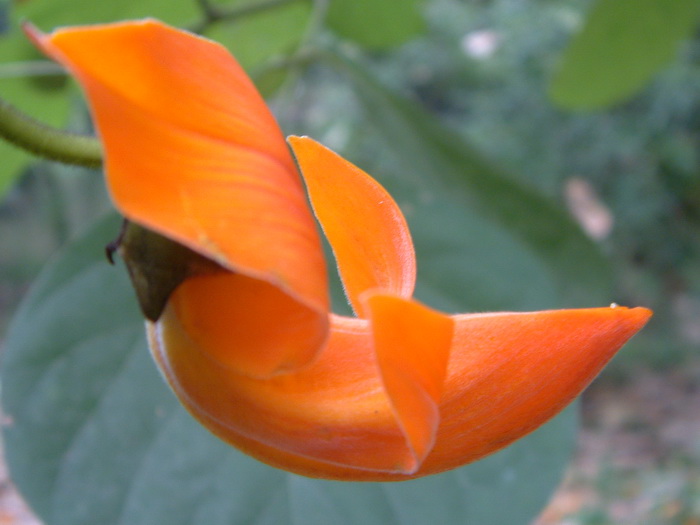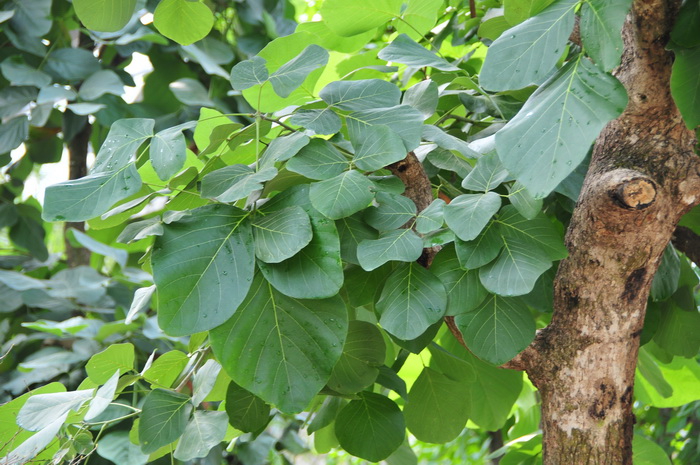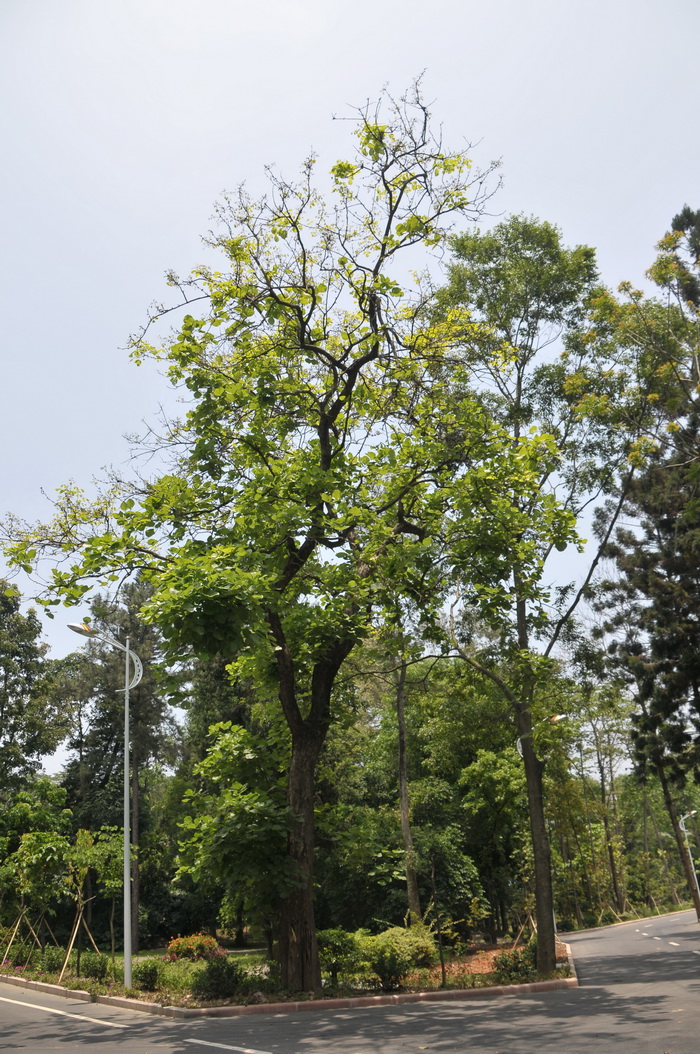紫矿Butea monosperma
中文名(Chinese Name):紫矿
学名(Scientific Name):Butea monosperma (Lam.) Taubert
英文名(English Common Name):Bengal kino
别名(Chinese Common Name):
异名(Synonym):Plaso monosperma (Lam.) Kuntze Butea braamania DC. Rudolphia frondosa (Willd.)Poir. Butea frondosa var. lutea (Witt.)Maheshw. Plaso monosperma var. flava Kuntze Plaso monosperma var. rubra Kuntze
科属(Family & Genus):蝶形花科,Fabaceae紫矿属
形态特征(Description):乔木,高10-20米,胸径达30厘米,树皮灰黑色。叶具长约10厘米的粗柄;小叶厚革质,不同形,顶生的宽倒卵形或近圆形,长14-17厘米,宽12-15厘米,先端圆,基部阔楔形,侧生的长卵形或长圆形,长11.5-16厘米,宽8.5-10厘米,两侧不对称,先端钝,基部圆形,两面粗糙,上面无毛,下面沿脉上被短柔毛,侧脉6-7对,与主脉在下面隆起,网脉在下面裸露,网眼明显;小叶柄粗壮,长约8毫米;小托叶钻状,长约1.5毫米。总状或圆锥花序腋生或生于无叶枝的节上,花序轴和花梗密被褐色或黑褐色绒毛,花萼长1-1.2厘米,外面密被紧贴的褐色或黑褐色绒毛,里面密被银灰色或淡棕色柔毛;花冠橘红色,后渐变黄色,比花萼约长3倍,旗瓣长卵形,外弯,长4.5-5厘米;翼瓣狭镰形,长约4厘米,基部具圆耳;龙骨瓣宽镰形,长5-5.5厘米,背部弯拱并合成一脊,基部具圆耳,各部密被银灰色绒毛;雄蕊内藏,花药长圆形;子房密被绒毛。未熟荚果扁长圆形,长12-15厘米,宽3.5-4厘米,被紧贴的银灰色短柔毛,先端钝圆,果颈长12-15毫米;种子宽肾形或肾状圆形,极压扁,高约2.7厘米,宽3.3-3.6厘米,褐红色。花期3-4月。
分布(Distribution):云南、广西有栽培,生于林中,路旁潮湿处。印度、斯里兰卡、越南至缅甸有分布。
用途(Use):本种是一经济价值较大的树种,是紫胶虫的主要寄主之一。其生产的紫胶,质地优良,是航空制造业上的重要粘合剂。此外,从树皮中的流出的红色液汁,干后变成赤胶,医药上用作收敛剂;花可作红色或黄色染料;种子可用于杀虫。
引自植物志英文版:FOC Vol. 10 Page 197, 222
Butea monosperma (Lamarck) Taubert in Engler & Prantl, Nat. Pflanzenfam. 3(3): 366. 1894.
紫矿 zi kuang | Fabaceae | Butea
Erythrina monosperma Lamarck, Encycl. 2: 391. 1786; Butea frondosa Roxburgh ex Willdenow, nom. illeg. superfl.
Trees, 10-20 m tall. Trunk to 30 cm d.b.h. Bark grayish black. Petiole ca. 10 cm, robust; stipels subulate, ca. 1.5 mm; petiolules robust, ca. 8 mm; leaflets unequal, thickly leathery, rough on both surfaces, puberulent along veins abaxially, glabrous adaxially, lateral veins 6 or 7 pairs, like midrib raised abaxially, reticulate veins distinct and with conspicuous areoles abaxially; terminal leaflet broadly obovate or suborbicular, 14-17 × 12-15 cm, base broadly cuneate, apex rounded or emarginate; lateral leaflets narrowly ovate or oblong, 11.5-16 × 8.5-10 cm, asymmetric, base rounded, apex obtuse or emarginate. Racemes or panicles axillary or at nodes of leafless branches; rachis, pedicels, and calyx outside densely brown or blackish brown velutinous. Calyx 1-1.2 cm, densely silvery gray on both surfaces or light brown pubescent inside. Corolla orange-red, becoming yellow later, ca. 3 × as long as calyx; standard narrowly ovate, recurved, 4-4.5 cm; wings narrowly falcate, ca. 4 cm, like keel with rounded auricles at base; keel broadly falcate, 5-5.5 cm, connate into an arcuate ridge, densely silvery gray velutinous. Anthers oblong. Ovary densely velutinous. Legumes 12-15 × 3.5-4 cm, adpressed silvery gray puberulent, apex rounded; stipe 12-15 mm. Seed reddish brown, broadly reniform or reniform-orbicular, compressed, ca. 2.7 × 3.3-3.6 cm. Fl. Mar-Apr.
Forests, wet places, near roads, also cultivated. SW Guangxi (Ningming), S and SW Yunnan (Gengma, Xishuangbanna) [Bhutan, Cambodia, India, Indonesia, Laos, Myanmar, Nepal, Sri Lanka, Thailand, Vietnam].
This species is one of the main host plants of lac insects. The red resin from the bark is used medicinally as an astringent.


 (责任编辑:徐晔春)
(责任编辑:徐晔春)
学名(Scientific Name):Butea monosperma (Lam.) Taubert
英文名(English Common Name):Bengal kino
别名(Chinese Common Name):
异名(Synonym):Plaso monosperma (Lam.) Kuntze Butea braamania DC. Rudolphia frondosa (Willd.)Poir. Butea frondosa var. lutea (Witt.)Maheshw. Plaso monosperma var. flava Kuntze Plaso monosperma var. rubra Kuntze
科属(Family & Genus):蝶形花科,Fabaceae紫矿属
形态特征(Description):乔木,高10-20米,胸径达30厘米,树皮灰黑色。叶具长约10厘米的粗柄;小叶厚革质,不同形,顶生的宽倒卵形或近圆形,长14-17厘米,宽12-15厘米,先端圆,基部阔楔形,侧生的长卵形或长圆形,长11.5-16厘米,宽8.5-10厘米,两侧不对称,先端钝,基部圆形,两面粗糙,上面无毛,下面沿脉上被短柔毛,侧脉6-7对,与主脉在下面隆起,网脉在下面裸露,网眼明显;小叶柄粗壮,长约8毫米;小托叶钻状,长约1.5毫米。总状或圆锥花序腋生或生于无叶枝的节上,花序轴和花梗密被褐色或黑褐色绒毛,花萼长1-1.2厘米,外面密被紧贴的褐色或黑褐色绒毛,里面密被银灰色或淡棕色柔毛;花冠橘红色,后渐变黄色,比花萼约长3倍,旗瓣长卵形,外弯,长4.5-5厘米;翼瓣狭镰形,长约4厘米,基部具圆耳;龙骨瓣宽镰形,长5-5.5厘米,背部弯拱并合成一脊,基部具圆耳,各部密被银灰色绒毛;雄蕊内藏,花药长圆形;子房密被绒毛。未熟荚果扁长圆形,长12-15厘米,宽3.5-4厘米,被紧贴的银灰色短柔毛,先端钝圆,果颈长12-15毫米;种子宽肾形或肾状圆形,极压扁,高约2.7厘米,宽3.3-3.6厘米,褐红色。花期3-4月。
分布(Distribution):云南、广西有栽培,生于林中,路旁潮湿处。印度、斯里兰卡、越南至缅甸有分布。
用途(Use):本种是一经济价值较大的树种,是紫胶虫的主要寄主之一。其生产的紫胶,质地优良,是航空制造业上的重要粘合剂。此外,从树皮中的流出的红色液汁,干后变成赤胶,医药上用作收敛剂;花可作红色或黄色染料;种子可用于杀虫。
引自植物志英文版:FOC Vol. 10 Page 197, 222
Butea monosperma (Lamarck) Taubert in Engler & Prantl, Nat. Pflanzenfam. 3(3): 366. 1894.
紫矿 zi kuang | Fabaceae | Butea
Erythrina monosperma Lamarck, Encycl. 2: 391. 1786; Butea frondosa Roxburgh ex Willdenow, nom. illeg. superfl.
Trees, 10-20 m tall. Trunk to 30 cm d.b.h. Bark grayish black. Petiole ca. 10 cm, robust; stipels subulate, ca. 1.5 mm; petiolules robust, ca. 8 mm; leaflets unequal, thickly leathery, rough on both surfaces, puberulent along veins abaxially, glabrous adaxially, lateral veins 6 or 7 pairs, like midrib raised abaxially, reticulate veins distinct and with conspicuous areoles abaxially; terminal leaflet broadly obovate or suborbicular, 14-17 × 12-15 cm, base broadly cuneate, apex rounded or emarginate; lateral leaflets narrowly ovate or oblong, 11.5-16 × 8.5-10 cm, asymmetric, base rounded, apex obtuse or emarginate. Racemes or panicles axillary or at nodes of leafless branches; rachis, pedicels, and calyx outside densely brown or blackish brown velutinous. Calyx 1-1.2 cm, densely silvery gray on both surfaces or light brown pubescent inside. Corolla orange-red, becoming yellow later, ca. 3 × as long as calyx; standard narrowly ovate, recurved, 4-4.5 cm; wings narrowly falcate, ca. 4 cm, like keel with rounded auricles at base; keel broadly falcate, 5-5.5 cm, connate into an arcuate ridge, densely silvery gray velutinous. Anthers oblong. Ovary densely velutinous. Legumes 12-15 × 3.5-4 cm, adpressed silvery gray puberulent, apex rounded; stipe 12-15 mm. Seed reddish brown, broadly reniform or reniform-orbicular, compressed, ca. 2.7 × 3.3-3.6 cm. Fl. Mar-Apr.
Forests, wet places, near roads, also cultivated. SW Guangxi (Ningming), S and SW Yunnan (Gengma, Xishuangbanna) [Bhutan, Cambodia, India, Indonesia, Laos, Myanmar, Nepal, Sri Lanka, Thailand, Vietnam].
This species is one of the main host plants of lac insects. The red resin from the bark is used medicinally as an astringent.
踩一下[0]

顶一下[2]